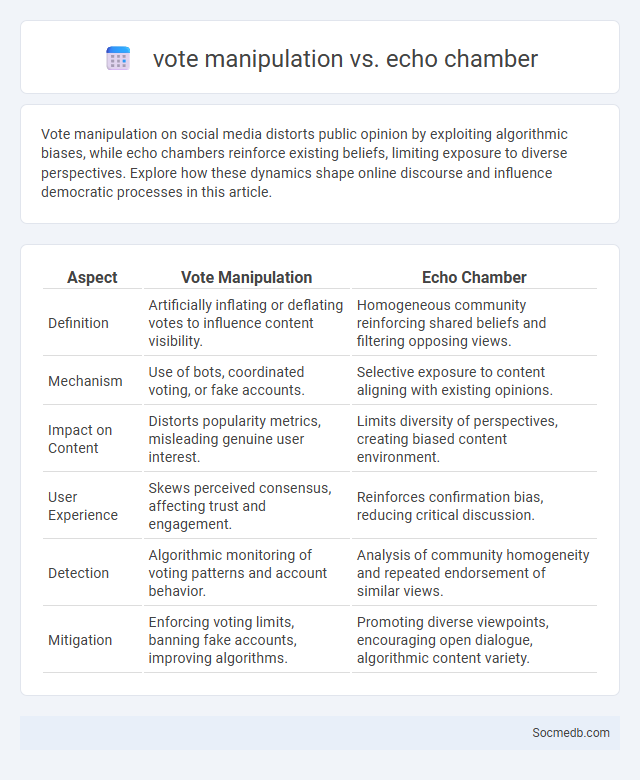
Photo illustration: vote manipulation vs echo chamber
Vote manipulation on social media distorts public opinion by exploiting algorithmic biases, while echo chambers reinforce existing beliefs, limiting exposure to diverse perspectives. Explore how these dynamics shape online discourse and influence democratic processes in this article.
Table of Comparison
| Aspect | Vote Manipulation | Echo Chamber |
|---|---|---|
| Definition | Artificially inflating or deflating votes to influence content visibility. | Homogeneous community reinforcing shared beliefs and filtering opposing views. |
| Mechanism | Use of bots, coordinated voting, or fake accounts. | Selective exposure to content aligning with existing opinions. |
| Impact on Content | Distorts popularity metrics, misleading genuine user interest. | Limits diversity of perspectives, creating biased content environment. |
| User Experience | Skews perceived consensus, affecting trust and engagement. | Reinforces confirmation bias, reducing critical discussion. |
| Detection | Algorithmic monitoring of voting patterns and account behavior. | Analysis of community homogeneity and repeated endorsement of similar views. |
| Mitigation | Enforcing voting limits, banning fake accounts, improving algorithms. | Promoting diverse viewpoints, encouraging open dialogue, algorithmic content variety. |
Understanding Vote Manipulation: Definition and Types
Vote manipulation on social media refers to the deliberate interference with user engagement metrics such as likes, shares, or poll votes to distort public opinion or sentiment. Common types include automated bot voting, coordinated group actions to inflate or deflate votes, and the use of fake accounts to create false consensus. Recognizing these tactics is critical for maintaining authentic interaction and ensuring credible feedback on digital platforms.
What is an Echo Chamber? Social Media and Groupthink
An echo chamber in social media refers to an environment where users are exposed predominantly to opinions and information that reflect their own beliefs, reinforcing existing views without challenge. This phenomenon intensifies groupthink by limiting exposure to diverse perspectives, which can lead to polarized communities and reduced critical thinking. Algorithms on platforms like Facebook and Twitter often amplify this effect by curating content based on user preferences and interactions.
Core Differences: Vote Manipulation vs Echo Chambers
Vote manipulation involves deliberately altering or influencing online engagement metrics to skew public opinion, while echo chambers occur when algorithms reinforce users' existing beliefs by filtering content that aligns with their views. Your exposure to diverse perspectives decreases in echo chambers, limiting critical thinking and perpetuating biases, whereas vote manipulation undermines the authenticity of social media feedback. Understanding these core differences helps you navigate social platforms more critically and promotes a healthier digital discourse.
Mechanisms Behind Vote Manipulation
Social media platforms often face challenges related to vote manipulation through coordinated bot networks, fake accounts, and algorithmic exploitation designed to amplify or suppress specific content. These mechanisms leverage automated scripts and artificially generated interactions to skew metrics such as likes, shares, or upvotes, undermining genuine user engagement. Advanced detection algorithms and machine learning models are continuously developed to identify and mitigate such fraudulent activities, preserving the integrity of online voting systems.
How Echo Chambers Reinforce Biases
Echo chambers on social media platforms amplify confirmation bias by selectively exposing users to information that aligns with their pre-existing beliefs. Algorithms prioritize content that resonates with a user's preferences, creating feedback loops that intensify ideological polarization. This environment limits exposure to diverse perspectives, reinforcing cognitive biases and deepening societal divisions.
The Algorithms: Facilitating Manipulation and Echoes
Social media algorithms prioritize content that maximizes user engagement by exploiting psychological triggers, often amplifying sensational or emotionally charged posts. These algorithms create echo chambers by curating personalized feeds that reinforce existing beliefs, limiting exposure to diverse perspectives. The resulting feedback loop facilitates manipulation by spreading misinformation and polarizing communities.
Psychological Impact of Vote Manipulation
Vote manipulation on social media can significantly distort public opinion, leading to increased polarization and misinformation. This psychological impact undermines trust in democratic processes, causing anxiety and skepticism among users. Protecting Your online environment from such manipulations is crucial for maintaining mental well-being and fostering informed decision-making.
Real-World Examples: Vote Manipulation and Echo Chambers
Social media platforms like Facebook and Twitter have experienced vote manipulation incidents, where coordinated campaigns spread misinformation to influence public opinion during elections. Echo chambers amplify this effect by curating content that reinforces users' existing beliefs, limiting exposure to diverse viewpoints. Studies show that these phenomena contribute to political polarization and reduce the quality of democratic discourse worldwide.
Combating Vote Manipulation and Breaking Echo Chambers
Social media platforms utilize advanced algorithms and artificial intelligence to detect and combat vote manipulation, safeguarding the integrity of online polls and elections. By promoting diverse content and encouraging engagement across different perspectives, these platforms work to break echo chambers that reinforce biased viewpoints. Your online experience becomes more balanced and trustworthy when platforms actively counteract manipulation and foster open dialogue.
Building Resilient Online Communities
Building resilient online communities requires fostering trust through transparent communication and active moderation to ensure respectful interactions. Encouraging diverse perspectives and providing clear guidelines helps your community navigate conflicts and adapt to challenges effectively. Consistent engagement and support empower members to contribute positively, enhancing the overall strength and longevity of your social platform.
 socmedb.com
socmedb.com